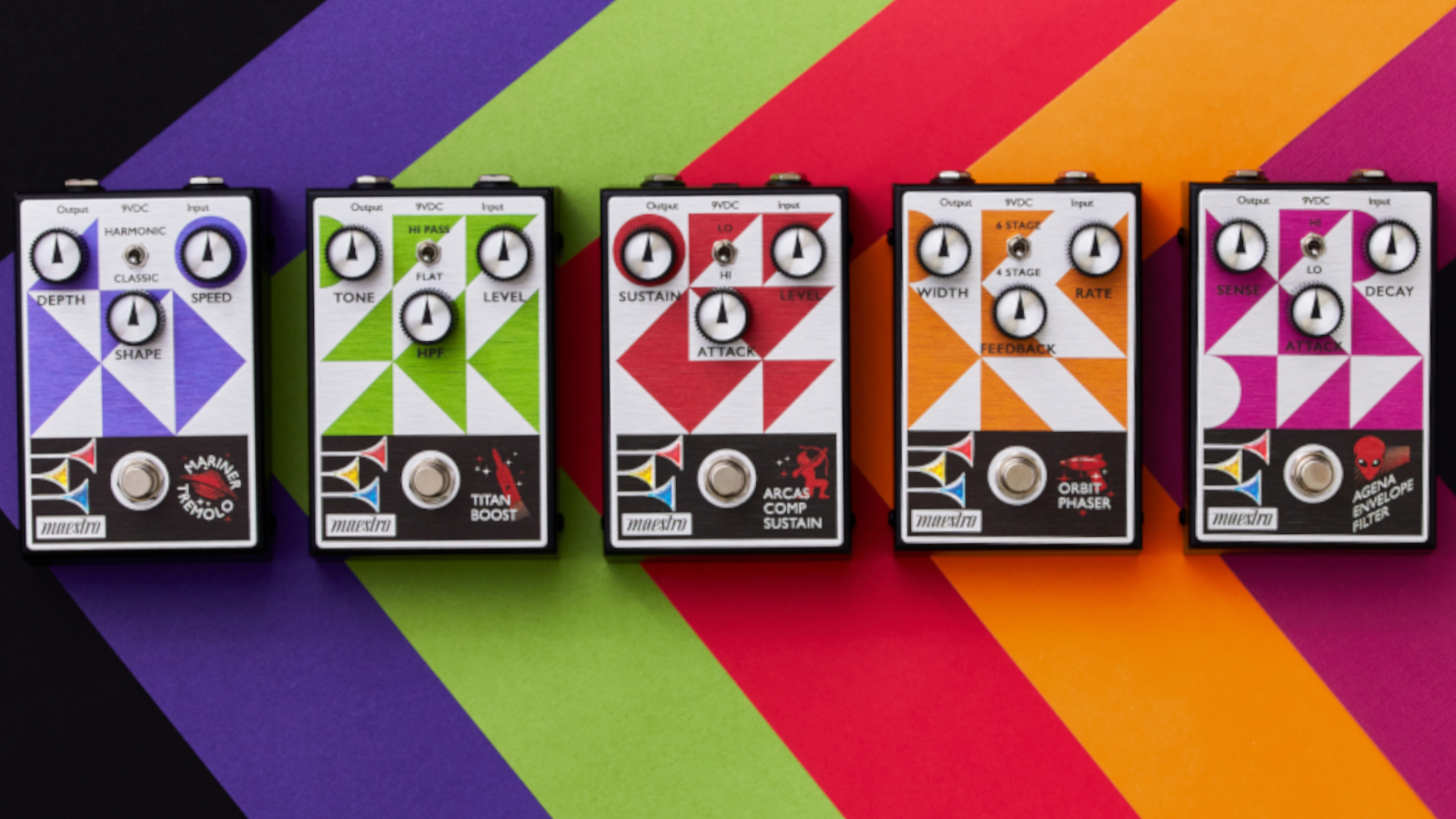GuitarPlayer Verdict
Straightforward in design, these vintage-leaning analog stompboxes are fun to use and provide a good variety of sounds
Pros
- +
[See below for individual pedals]
Cons
- -
[See below for individual pedals]
You can trust Guitar Player.
The latest group of Maestro pedals covers boost, compression, envelope filter, phase shifting and tremolo.
Like the debut models we reviewed last year (the FZ-M Fuzz-Tone, Comet Chorus, Discoverer Delay, Invader Distortion and Ranger Overdrive) they feature wedge-shaped steel housings with vintage-style brushed-aluminum decal graphics and a lighted “three bugles” on/off indicator.
All are true-bypass analog designs
They also keep the same format of three knobs and a mini-toggle switch that, depending on the effect, provides two parameter options for enhanced functionality.
The input, output and adapter jacks are on the front panel, which allows for placing the pedals close together on a pedalboard.
All are true-bypass analog designs and, unlike the debut models, do not have internal trim pots.
The enclosures open easily when you loosen four screws (they don’t have to be removed), allowing you to access the clip for a nine-volt battery (not included) – handy if it’s inconvenient to be tethered to an adapter (also not included).
I tested all five pedals with a Telecaster, a Reverend Crosscut and a Slick SL56 plugged into a Fender Deluxe Reverb and a mid-’60s Vibro-Champ combo.
All the latest guitar news, interviews, lessons, reviews, deals and more, direct to your inbox!
Agena Envelope Filter
- FOR: Tracks well. Hi/Lo switch provides useful tone options
- AGAINST: None
The Agena Envelope Filter delivers classic auto-wah effects via its sense (sensitivity), decay and attack controls, along with a Hi/Lo switch that selects the filter’s frequency range. Set the switch to Hi for a sharper tone or to Lo for a bassier response.
A sweet-sounding pedal that tracks picking dynamics very well
The accompanying literature points out that a Maestro BG-1 or BG-2 Boomerang Wah pedal was used by legendary Stax Records session guitarist Charles “Skip” Spence on the 1971 recording “Theme From Shaft.”
It’s not clear if the Agena is based on any ’70s-era circuitry, but it is a sweet-sounding pedal that tracks picking dynamics very well, making it feel like you’re working the rocker on a wah pedal to create sharper “toe-down” effects and rounder timbres – all with a nice vocal character – when you back off on your picking.
I like the sounds with sensitivity at noon or thereabouts (depending on whether I’m playing humbuckers or lower-output single-coils), attack (which sets how quickly the filter opens) at around one o’clock and decay (which adjusts how long the filter stays open) at two o’clock or higher.
It’s like wah-wah without having to think about it
The controls don’t have radical amounts of range, and that could be a good thing because the Agena sounds warm and natural and is fun to play with.
You can find a lot of reasons to just leave it on for rhythm and melodic parts, where the embellishing qualities of wah can be so organically woven into the music when you’re not anchored to a rocker pedal.
It’s like wah-wah without having to think about it. It’s an addictive thing, too, and the Agena gives you the essentials you need to get your Jerry Garcia groove on with this hip effect.
Arcas Compressor Sustainer
- FOR: Smooth compression, quiet operation. Useful Hi/Lo function
- AGAINST: None
A totally different experience is the Arcas Compressor Sustainer, which has sustain, attack and level controls, and a Low/Hi switch that, in the latter position, provides greater sensitivity to picking dynamics.
The Arcas is very unobtrusive, and you can basically have it on and get very comfy with the smoothing qualities it brings to your playing.
The Arcas is very unobtrusive
This is where compression is at its best, in my opinion, but the Arcas can be more effect-y sounding with sustain (which varies the amount of gain applied during compression) set at around three o’clock, attack (which adjusts how quickly the compression engages) at two o’clock and level around one o’clock or whatever it takes to give a little boost to the output or mitigate level loss caused by compressing the signal.
With the switch set to Hi, Arcas added a nice juiciness to slide parts, and I liked how it doesn’t change the dynamic feel but rather just makes everything sustain longer and sound meatier in the process.
The Arcas does the job effectively and is very quiet and transparent, making it ideal for guitarists who can appreciate a compressor that doesn’t overtly affect that all-important dynamic feel.
Mariner Tremolo
- FOR: Wide range of tremolo sounds available via the Harmonic/Classic switch
- AGAINST: None
The Mariner tremolo is another well-implemented pedal that offers the choice of Classic and Harmonic modes via its two-position mode switch.
Classic mode provides amplitude modulation to deliver warm, amp-style tremolo
This pedal is a straightforward three-knobber, with controls for depth (varies the intensity of the effect), shape (progressively alters the waveform shape from triangle to square) and speed (modulation rate).
However, in combination with the aforementioned mode switch, a surprisingly wide range of tremolo textures are available here.
Classic mode provides amplitude modulation to deliver warm, amp-style tremolo when you set shape to noon or thereabouts.
The effect is nice and thick with the depth knob all the way up, and turning the shape control toward maximum yields progressively choppier sounds that really stand out at higher speed settings and can be useful for embellishing breaks or other dynamic shifts in a song.
Harmonic mode introduces frequency amplitude modulation
Harmonic mode introduces frequency amplitude modulation, which has pitch-bend color and sounds that are closer to a rotary speaker.
I like it with depth at maximum, shape at around 11 o’clock, and speed either on the slow side, for a watery, Robin Trowe-style tone, or faster, for a shimmering Lonnie Mack-style sound, especially played through a lower-gain amp boosted into breakup.
The versatility of the Mariner makes it a good choice if you’re looking for a basic tremolo pedal that has something extra up its sleeve.
Orbit Phaser
- FOR: Delivers sweet-sounding phasing with a choice of 4- and 6-stage operation
- AGAINST: None
It would be unthinkable not to have a phase shifter in the new Maestro lineup, and the Orbit Phaser answers the need in a juicy-sounding pedal that features controls for width (adjusts the effect’s intensity), feedback (sets the amount of vocal phase effect) and rate, plus a 4-Stage/6-Stage switch that provides classic, bold phasing textures in the former position and a slightly thinner, smoother and perhaps more hi-fi response in the latter position.
A good choice if your tastes lean in a vintage direction and you love the swirly coolness of this primordial effect
They both sound good in different ways, and I liked the overall response with the width and feedback controls at around one and two o’ clock respectively, and rate set for a rich, chewy sound at around 10 o’clock.
From there the tones can be easily slanted toward classic EHX Small Stone/MXR Phase 90 sounds with a little tweaking of the controls.
The Orbit Phaser is a good choice if your tastes lean in a vintage direction and you love the swirly coolness of this primordial effect, whether using it to add tasty color, like ’70s-era Keef, or as a tone shaper to help facilitate the “brown sound,” as per early EVH.
Titan Boost
- FOR: Powerful clean boost. Handy HFP mode provides enhanced tone-shaping
- AGAINST: None
The Titan Boost begins as a garden-variety booster with tone and level controls, but it adds a nifty twist courtesy of the mode switch, with its Flat and Hi Pass settings.
You can fine-tune the tones quickly and easily
The latter operates in conjunction with a third knob labeled HPF that lets you adjust the high-pass filter’s bandwidth and is only operable when the switch is on the Hi Pass setting.
The cool thing here is you can fine-tune the tones quickly and easily by using the HPF knob to do things like tame shrillness inflicted by single-coils or eliminate low-end muddiness that humbuckers can cause.
In Flat mode the Titan simply adjusts tone and level, which may be all that’s needed to give your guitar signal a girthy boost of 25dB or more to overdrive the front end of a tube amp.
A very capable boost pedal that gives you two distinctly different ways to shape your tone
I found it worked well in that role, letting me get more grind from a Deluxe without changing its core tone, and the Titan proved to be a cool alternative to switching on an OD pedal, which invariably colors the sound to some degree, even though that may be exactly what you want.
A booster can also be an essential part of the pedal chain when placed before or after a distortion pedal to give some extra lift when it’s needed.
The Titan is a very capable boost pedal that gives you two distinctly different ways to shape your tone, while retaining the simplicity and ease of use that are fundamental qualities of all these models in the Maestro line.
Specifications
All Pedals
- CONTACT: maestroelectronics.com
- EXTRAS: Battery power option
- SIZE: 5.044” x 3.45” x 2.5” (LxWxH), including knobs
- WEIGHT: 1.24 lbs (tested)
- BUILT: China
Agena Envelope Filter
- PRICE: $159
- CONTROLS: Sense, decay, attack. Hi/Lo switch
Arcas Compressor Sustainer
- PRICE: $149
- CONTROLS: Sustain, attack, level. Hi/Lo switch
Mariner Tremolo
- PRICE: $154
- CONTROLS: Depth, shape, speed. Harmonic/ Classic switch
Orbit Phaser
- PRICE: $149
- CONTROLS: Width, feedback, rate. 6 Stage/4 Stage switch
Titan Boost
- PRICE: $154
- CONTROLS: Tone, HPF, level. High Pass/Flat switch
Visit Maestro for more information.

Art Thompson is Senior Editor of Guitar Player magazine. He has authored stories with numerous guitar greats including B.B. King, Prince and Scotty Moore and interviewed gear innovators such as Paul Reed Smith, Randall Smith and Gary Kramer. He also wrote the first book on vintage effects pedals, Stompbox. Art's busy performance schedule with three stylistically diverse groups provides ample opportunity to test-drive new guitars, amps and effects, many of which are featured in the pages of GP.

